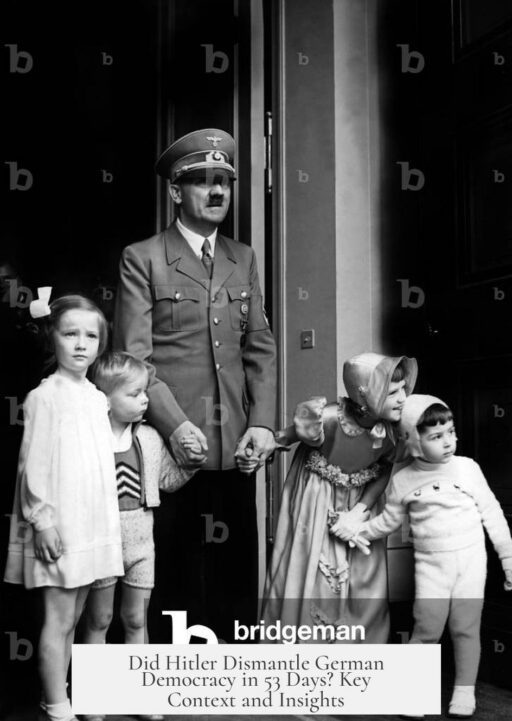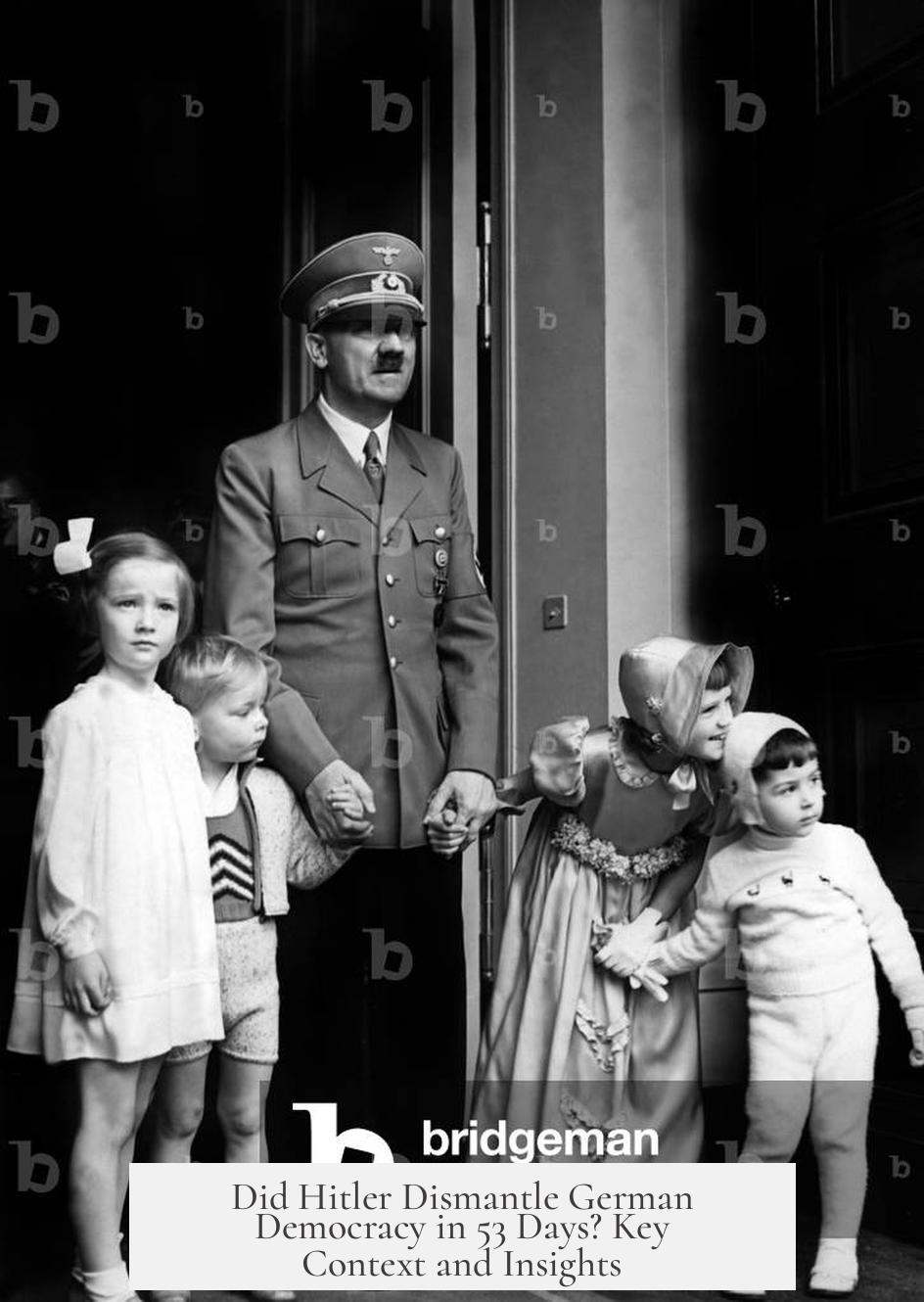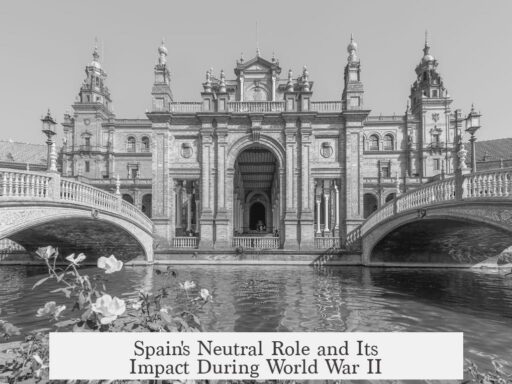The claim that Hitler dismantled democracy in Germany within 53 days is broadly accurate but requires significant contextual understanding. This 53-day period spans from Hitler’s appointment as Chancellor on January 30, 1933, to the passing of the Enabling Act on March 23, 1933. During this short timeframe, the Nazis moved swiftly to consolidate power and neutralize democratic structures. However, the dismantling was part of a longer, more complex process that involved prior weakening of the Republic and collaboration from various elites.
After being appointed Chancellor, Hitler and the Nazi Party implemented a strategy called Gleichschaltung or synchronization. This aimed to ensure that all political bodies, professional institutions, and societal levers aligned with Nazi ideology and control. This process eliminated independent organizations and opposition, making the entire state apparatus an extension of Nazi power. The speed and thoroughness of this political transformation contributed to the perception that democracy was dismantled almost overnight.
| Date | Event | Significance |
|---|---|---|
| January 30, 1933 | Hitler appointed Chancellor | Official Nazi entry into government power |
| February 27, 1933 | Reichstag Fire | Used as pretext to pass Reichstag Fire Decree |
| February 28, 1933 | Reichstag Fire Decree enacted | Suspended civil liberties, enabling repression of opponents |
| March 23, 1933 | Enabling Act passed | Grants Hitler legislative powers without Reichstag or president approval |
The Reichstag Fire on February 27 was a critical moment. The Nazis blamed communist conspirators, using the event to justify the Reichstag Fire Decree. This decree suspended key constitutional safeguards including habeas corpus. This escalation permitted widespread arrest and intimidation of political rivals, particularly communists and social democrats. Such actions effectively paralyzed opposition and instilled a climate of fear.
The Enabling Act was the final legal instrument that terminated parliamentary democracy. With the Reichstag intimidated, bribed, or coerced into passing the act, Hitler’s cabinet could legislate autonomously. This law stripped the Reichstag and President Hindenburg of real power, codifying a legal dictatorship. Although the Nazis already controlled the government, this legislation sealed their authority.
Understanding the 53-day narrative requires acknowledging what preceded it. Hitler’s rise was not sudden. From 1930 onward, the Weimar Republic faced severe crises. Conservative elites, military leaders, and establishment figures undermined democratic institutions. They believed they could control Hitler or that Nazism was a lesser evil compared to other threats. These elites paved the way for the Nazi seizure of power by destabilizing the democratic system and abetting authoritarian tendencies.
Many non-Nazi actors contributed to the dismantling, driven by fear, opportunism, or political calculation. The military, bureaucrats, businessmen, and some middle-class citizens supported or acquiesced to the unfolding dictatorship. This complex social dynamic enabled the rapid consolidation after Hitler’s official appointment.
Thus, the “53 days” figure is a shorthand for a more complicated historical process. Within those days, democracy was legally and forcefully dismantled. But this milestone was reached because democracy had been eroding well before. It was the culmination of strategic moves by Nazis and their allies.
- The 53-day period marks the time from Hitler’s chancellorship to the Enabling Act passage.
- Gleichschaltung was the process of Nazifying all institutions and eradicating dissent.
- Reichstag Fire Decree curtailed civil rights and allowed persecution of political opponents.
- The Enabling Act gave Hitler dictatorial legislative powers, ending parliamentary democracy.
- Pre-existing political crises and elite support significantly enabled Nazi ascension.
- Many non-Nazis collaborated or acquiesced due to various motivations.
Accurately understanding the Nazi dismantling of democracy involves recognizing the rapid legal and political steps in early 1933 alongside broader structural weaknesses in the Weimar Republic. The 53 days show how quickly a democracy can collapse under coordinated authoritarian strategies but do not capture the full context of that collapse.
Did Hitler Really Dismantle Democracy in 53 Days? Let’s Break It Down
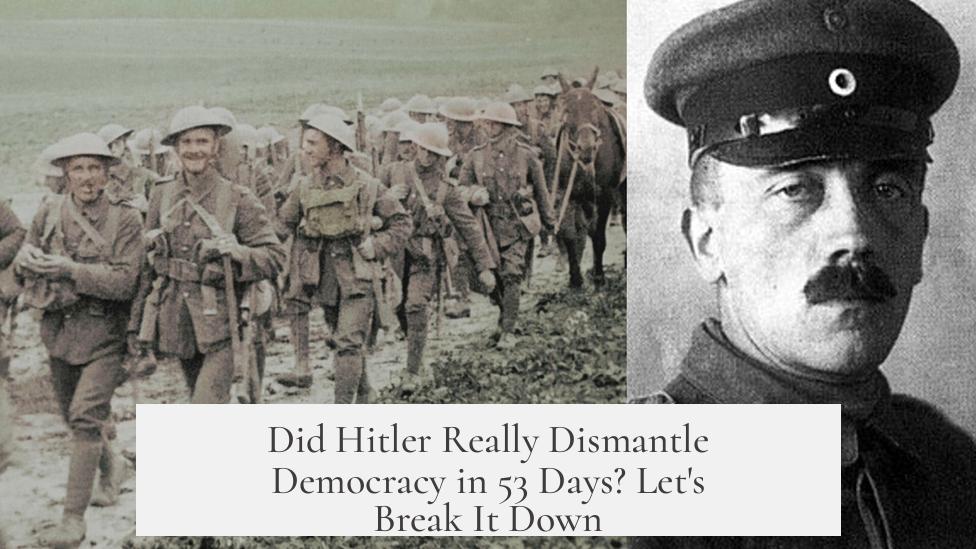
Yes, the claim that Hitler dismantled German democracy in roughly 53 days holds truth—but with important context that changes how we understand those 53 days and the forces behind them. That’s the quick answer. Now, let’s unpack the story behind the headlines and viral posts you’ve been seeing.
January 30, 1933: Adolf Hitler is appointed Chancellor of Germany. March 23, 1933: The Reichstag passes the Enabling Act. That’s where the “53 days” figure comes from. This law handed Hitler’s cabinet the power to legislate without Reichstag or presidential approval. In simple terms? It gave Hitler dictatorial powers legally and effectively ended Weimar Germany’s fragile democracy.
So—why does this matter?
Fifty-three days sounds fast. It is fast. But this rapid dismantling was just the climax of careful groundwork laid over many years. It also took a secret army of collaborators and prior mistakes by democratic Germany’s own elite to get Hitler into a position where he could do this.
The Long Road to Destroy Democracy
It’s tempting to imagine Hitler magically snapping his fingers after January 30, 1933, and instantly creating a totalitarian state. But the picture is far more complex. Hitler’s rise was a slow-burn process starting soon after World War I.
- In September 1919, Hitler joins the German Workers’ Party.
- By early 1920, he’s the party’s de facto leader and rechristens it the National Socialist German Workers’ Party (NSDAP).
- November 1923 sees the infamous Beer Hall Putsch, an attempted coup that fails spectacularly, landing Hitler in prison.
- Post-prison, he opts for a more strategic, “democratic” path to power.
- The Great Depression from 1929 onward provides fertile ground for the Nazis to grow faster.
- By 1932, the Nazi Party becomes the largest Reichstag faction.
- January 30, 1933: Hindenburg appoints Hitler Chancellor, thinking he can be controlled.
Hitler’s 53-day “magic” was actually the final act of a decade-long drama played out on a volatile stage.
What Happens in Those Famous 53 Days?

From the moment Hitler is Chancellor, the Nazis spring into action, kicking off the process called Gleichschaltung—a German word meaning “coordination” or “synchronization.” It’s a fancy way of saying Nazis forcibly aligned all political, professional, and social institutions under their control.
No independent courts, political parties, or organizations left standing. The bureaucracy becomes a Nazi machine. Professional bodies purge “anti-Nazi” members. The press is muzzled. Opposition crushed. Sound like democracy? Far from it.
Two key legal strikes happen here:
- The Reichstag Fire Decree: Passed after a suspicious fire at the Reichstag one month post-appointment. This decree suspended key civil liberties, like freedom of speech and habeas corpus. It permitted the Nazis to arrest political opponents en masse without due process.
- The Enabling Act: Passed amid threats and bribery, it allowed Hitler’s cabinet to make laws without parliamentary input or presidential veto. It effectively made him a dictator under the law.
These laws dismantle democratic protections in lightning speed.
It Wasn’t Just Hitler—The Supporting Cast Made It Possible
Could Hitler have pulled off this rapid dismantling solo? No. He had help. Not the mystical kind, but from people very much real and powerful.
Backstage were conservative elites like Franz von Papen and President Paul von Hindenburg. They underestimated Hitler, thinking they could control him or use him against communists and other threats. Spoiler: They were wrong.
The military, local administrators, opportunists, and many ordinary Germans—all played roles, willingly or not. Some were motivated by fear, some by ambition, some by indifference, others by sheer survival instincts. The idea that Hitler single-handedly destroyed democracy ignores this vital collective involvement.
This raises an uncomfortable but crucial question: how many around us today would act like these collaborators did when democracy is fragile?
The Weimar Republic’s Fragile Foundations
To understand how Hitler’s blitz was possible, one must glance at the Weimar Republic that preceded him.
Despite some democratic gains in the 1920s, Weimar was always fragile. Its judicial system was saturated with anti-democratic bias. Antisemitism simmered beneath the surface, never far from mainstream politics. Political violence and coup attempts peppered its early years.
The real killers of democracy were some of the Republic’s own defenders—conservative and monarchist elites who preferred authoritarian rule to the democratic experiment. They stabbed the Republic in the back multiple times by employing emergency powers and authoritarian cabinets, weakening democratic norms.
By 1930, the Republic was barely breathing. Hitler did not topple a vibrant democracy; he claimed the remains of one already on life support.
Why Should We Care About the “53-day” Narrative?
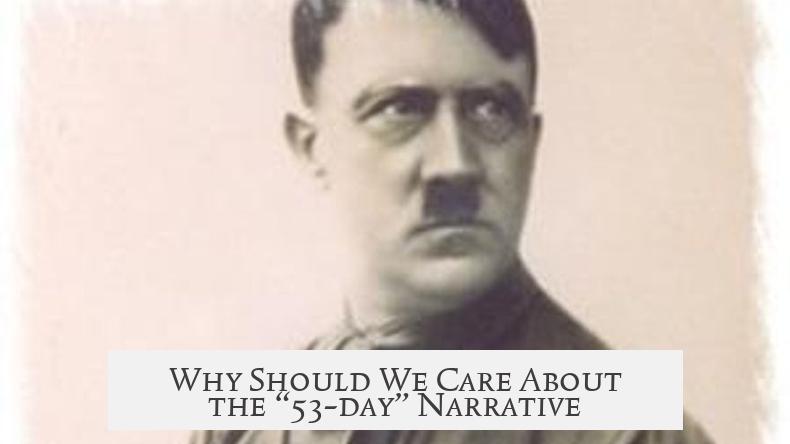
Saying Hitler dismantled democracy in 53 days is catchy. It fits neatly into a Twitter headline or a meme. But it oversimplifies a complicated historical reality. It risks suggesting that democracy’s fall was an abrupt catastrophe caused by one man’s whim alone.
That’s not the case. Democracy’s erosion was gradual but relentless. It was a process that involved many actors, pre-existing vulnerabilities, and societal dynamics. Understanding this full context helps us spot similar dangers today, preventing history from repeating.
As historian Henry Ashby Turner, Jr., famously put it in his 1997 book Hitler’s Thirty Days to Power: January 1933, the early months of 1933 were crucial—but they were preceded by much groundwork. Turner’s detailed account highlights how quickly events escalated, but also how much was built before Hitler’s appointment.
For those curious about social institutions’ role in this dark chapter, Robert Proctor’s Racial Hygiene: Medicine Under the Nazis explains how Nazi ideology seeped into the medical profession, reflecting Gleichschaltung beyond politics.
A Brief Look Ahead: Lessons for Today
What can we learn from this? First, democracy can be fragile, especially when under strain from economic crises, social divisions, and political polarization. Second, the speed of democratic backsliding can shock, but it rarely happens in a vacuum.
Unchecked elites, complicit institutions, and a fragmented opposition all clear the way for authoritarianism. The “53 days” is a warning: when democracy falters, destruction can arrive fast—often with silent consent from many quarters.
How to Stay Vigilant?
- Support independent institutions fiercely. No bureaucracy or court should be above scrutiny.
- Question narratives that reduce complex history to neat timeframes. Dig deeper.
- Recognize that democracy requires active maintenance, with citizens alert to abuses.
- Remember that evil rarely works alone: those who enable it bear responsibility.
- Engage in community dialogue to prevent fear or apathy from crippling civic life.
The rise and rapid seizure of power by the Nazis confirms that putting all your faith in one leader—or one party—to “fix” all problems can be a dangerous gamble. Democratic safeguards and pluralism aren’t perfect, but they build resilience.
Final Thoughts
So yes, Hitler accelerated the death of German democracy in 53 days after becoming Chancellor. But those 53 days were the thunderclap after years of simmering political chaos, societal fractures, and elite miscalculations. The Nazis didn’t create the crisis; they exploited it with brutal efficiency.
Posts stating “it only took 53 days” are, therefore, partially right but incomplete. They miss the deeper story that democracy’s fall didn’t come from nowhere—it was a process involving many people and factors over time.
Understanding this fuller context not only helps us grasp history more accurately, but it warns us to nurture, protect, and never take democracy for granted.
“Those who cannot remember the past are condemned to repeat it.” — George Santayana
